| ARTICLES
ON MERLENE OTTEY |
|
No
doubt about Merlene’s innocence
 Those
of us who support good science and have conducted any research on
steroids and sports in general and Nandrolone in particular are not
surprised at the decision by the International Amateur Athletic
Federation (IAAF) arbitration panel in the case of Jamaica’s track
legend Merlene Ottey. My worry was whether the panel would succumb
to the pressure of the IAAF. Fortunately the panel demonstrated its
integrity by making a decision based on the weight of the evidence
presented, just as the local panel did. Those
of us who support good science and have conducted any research on
steroids and sports in general and Nandrolone in particular are not
surprised at the decision by the International Amateur Athletic
Federation (IAAF) arbitration panel in the case of Jamaica’s track
legend Merlene Ottey. My worry was whether the panel would succumb
to the pressure of the IAAF. Fortunately the panel demonstrated its
integrity by making a decision based on the weight of the evidence
presented, just as the local panel did.
The
whole matter of setting limits and testing for metabolites of
Nandrolone is fraught with uncertainty and disagreement. Searching
questions are being asked about the limits set by the IAAF for this
particular drug by several individuals and organizations, including
FIFA, but in this instance I wish to address the other side of the
issue – that of the analyses.
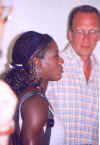 There
seems to be the impression that Merlene has escaped on a
"technicality". The fact is that sampling, storage and
analytical methods affect results of analyses. Using inorganic
geochemistry as an example, if I am testing rocks for the element
sodium (found in common salt), I would get the sample into the
appropriate solution and then carry out my analyses. But I cannot
store the solution in glass flasks because the sodium in the glasd )
by mys will be leached (absorbe sample solution, giving me results
which are higher than they should be. The significance of the error
so introduced will depend on the level of sodium in my sample. There
seems to be the impression that Merlene has escaped on a
"technicality". The fact is that sampling, storage and
analytical methods affect results of analyses. Using inorganic
geochemistry as an example, if I am testing rocks for the element
sodium (found in common salt), I would get the sample into the
appropriate solution and then carry out my analyses. But I cannot
store the solution in glass flasks because the sodium in the glasd )
by mys will be leached (absorbe sample solution, giving me results
which are higher than they should be. The significance of the error
so introduced will depend on the level of sodium in my sample.
Other
examples of samples being affected by various conditions could be
quoted; the most familiar to readers would be substances which are
placed in dark bottles because they are sensitive to light. In some
cases the sample could be temperature sensitive, in others it could
be pH, (acidity). Because of such reasons, the exact way of carrying
out analyses and doing calculations for results are established, and
analysts are required to follow them exactly and to do the correct
thing every time.
If
specific gravity (s.g.) is important in the calculation of the
results in this particular test, and the specific gravity of the
sample can change, this change must be kept to a minimum and it must
be clearly stated which value of the s.g. is to be used. This is
where the chain of custody of the sample becomes critical. The
sample has to be kept under very controlled conditions if the
analysis is not being done at the time of sampling. Some person or
persons must take responsibility for ensuring that these conditions
are met exactly until the test is completed. In the case of the
samples of Merlene’s urine taken by the IAAF, this was not done.
Not only was the chain of custody compromised, the conditions under
which the samples were kept were, apparently, inappropriate.
Another
consideration is that at low concentrations, very small errors can
be significant. So going back to my rock sample, if my rock contains
forty percent sodium, then if twenty parts per million leach into
the solution from my container, it will not significantly affect my
result. If however my sample concentration is five parts per million
and one part per million leaches into the solution, I have a
significant error. At the minute concentrations being analysed in
the case of nandrolone metabolites, a small error in the s.g. can be
significant.
Reduction
of error is an integral part of all analytical work, and the amount
of the error associated with each result must be calculated and
stated. If the error introduced is too large, the result must be
rejected. The analyst who does not diligently and carefully follow
correct procedures can place no trust in the results obtained and
should redo the analysis.
Based
on the evidence presented to the arbitration panel, Merlene could
have been exonerated on various grounds. The one stated, however,
allowed the IAAF to save face. Hence, even though the panel of
arbitrators did the right thing in the end, several fundamental
questions remain to be answered about the Federation’s anti-doping
programme.
Special
commendations to those who supported Merlene during this difficult
time, with honorable mention going to the JAAA which showed moral
courage by not rushing to judgment in order to please its parent
organization the IAAF.
Dr
Barbara Carby (Red Hills P O, Kingston, Jamaica) |
| REUTERS'
report on her first race in Italy |
|
Athletics-Ottey
fails to impress on reappearance
By
Luke Baker
NUORO,
Sardinia, July 12
Jamaican
sprinter Merlene Ottey rejoined the international athletics fold on
Wednesday, almost a year after failing a drugs test, but her form
failed to impress 10 weeks ahead of the Olympics.
At
a local meeting in the small town of Nuoro, tucked away in the
mountains of central Sardinia, Ottey blew away the unrecognised
opposition, but still ran home in only 11.42 seconds, far outside
what she was hoping to achieve.
``Its
too cold, I was kind of hoping the weather would be better,'' she
said after the race.
Sardinia
is normally warm at this time of year, and Nuoro is at a reasonable
altitude of 500 metres, conditions Ottey said she was hoping would
contribute to a run somewhere around 11.20, but the weather was
unseasonally cold and blustery.
``Mentally,
I didn't want a big meet, and there arent too many races elsewhere,
but I thought conditions would be better,'' she added.
The
time was way outside her personal best of 10.74, a benchmark she is
hoping to better at the Olympics - her last major competition.
``I've
already achieved my goals over the past 20 years. It's going to be
time to give it a rest,'' she said.
Ottey,
now 40, has been around at the top of athletics since the Moscow
Olympics in 1980 when she took a bronze medal in the 200 metres, but
a year ago she tested positive for the controversial anabolic
steriod nandrolone and was banned.
The
winner of 34 medals in major international championships, including
seven Olympics and a record 14 in world championships, she denied
ever knowingly taking the drug.
PANEL
RULING
An
International Amateur Athletic Federation arbitration panel ruled on
July 3 that ``there were not the grounds to maintain her suspension
from competition,'' ending the ban with immediate effect.
The
suspension came after a meeting in Lucerne, Switzerland in July last
year, when Ottey ran 10.97 in the 100 metres and 22.40 in the 200
metres.
With
the enquiry behind her, Ottey is hoping to get her mind completely
focused on the build up to Sydney, but she said the year-long saga
had had a pyschological impact.
``It's
been tough, and mentally it was difficult to focus, but now I have
some time before the Olympics and I'm going to train hard and have a
try,'' she said.
``I'm
keen just to run, just to get back in the race,'' she added.
Coach
Slovenian Srdjan Djordjevic said he was disappointed with
Wednesday's race, but felt there was still time to get it right
before September. He said Ottey was likely to compete in races
either in Stockholm or Zurich during August, following the Jamaican
Olympic trials on July 21-22.
``There's
no doubt she can run faster, but it needs to be warmer. I think if
the conditions are right, she can be fast enough for something under
10.90,'' he said.
NUORO,
Sardinia
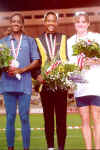 Jamaican
sprinter Merlene Ottey rejoined the international athletics fold on
Wednesday, almost a year after failing a drugs test, but her form
failed to impress 10 weeks ahead of the Olympics. Jamaican
sprinter Merlene Ottey rejoined the international athletics fold on
Wednesday, almost a year after failing a drugs test, but her form
failed to impress 10 weeks ahead of the Olympics.
At
a local meeting in the small town of Nuoro, tucked away in the
mountains of central Sardinia, Ottey blew away the unrecognized
opposition, but still ran home in only 11.42 seconds, far outside
what she was hoping to achieve.
"Its
too cold, I was kind of hoping the weather would be better,"
she said after the race.
Sardinia
is normally warm at this time of year, and Nuoro is at a reasonable
altitude of 500 meters, conditions Ottey said she was hoping would
contribute to a run somewhere around 11.20, but the weather was
unseasonably cold and blustery.
"Mentally,
I didn't want a big meet, and there aren't too many races elsewhere,
but I thought conditions would be better," she added.
The
time was way outside her personal best of 10.74, a benchmark she is
hoping to better at the Olympics -- her last major competition.
"I've
already achieved my goals over the past 20 years. It's going to be
time to give it a rest," she said.
Ottey,
now 40, has been around at the top of athletics since the Moscow
Olympics in 1980 when she took a bronze medal in the 200 meters, but
a year ago she tested positive for the controversial anabolic
steroid nandrolone and was banned.
The
winner of 34 medals in major international championships, including
seven Olympics and a record 14 in world championships, she denied
ever knowingly taking the drug.
An
International Amateur Athletic Federation arbitration panel ruled on
July 3 that "there were not the grounds to maintain her
suspension from competition," ending the ban with immediate
effect.
The
suspension came after a meeting in Lucerne, Switzerland in July last
year, when Ottey ran 10.97 in the 100 meters and 22.40 in the 200
meters.
With
the inquiry behind her, Ottey is hoping to get her mind completely
focused on the build up to Sydney, but she said the year-long saga
had had a psychological impact.
"It's
been tough, and mentally it was difficult to focus, but now I have
some time before the Olympics and I'm going to train hard and have a
try," she said.
"I'm
keen just to run, just to get back in the race," she added.
Coach
Slovenian Srdjan Djordjevic said he was disappointed with
Wednesday's race, but felt there was still time to get it right
before September. He said Ottey was likely to compete in races
either in Stockholm or Zurich during August, following the Jamaican
Olympic trials on July 21-22.
"There's
no doubt she can run faster, but it needs to be warmer. I think if
the conditions are right, she can be fast enough for something under
10.90," |
|
AFP's
report on her first race in Italy
|
|
Merlene
Ottey returns to competition
12 July 2000 - Nuoro,
Sardinia
Jamaican
sprinter Merlene Ottey returned to competition Wednesday by winning
the 100 meters in a regional meet on this Italian island.
''It
felt good to get started again,'' the 40-year-old five-time Olympian
said moments after the race. ''My goal now is to get to Sydney and
reach 20 years of Olympics.''
Ottey,
a double silver medalist at the 1996 Games,had no problem cruising
to the win in Sardinia on Wednesday over a field of regional
runners, winning in a relatively slow time of 11.42 seconds under
chilly conditions.
Ottey
said the past week has been a whirlwind, since learning of her
immediate reinstatement. ''I was so excited, it was one of the best
pieces of news of my life,'' Ottey said. ''Now I have to step up my
training and focus on the mental element.''
Her
next competition will be the Jamaican national championship, July
20-22 where she will run the 100 and 200 meters, seeking to qualify
for her sixth Olympic Games.
Ottey
has won 34 individual medals in major international championships
and is a former world 200-meter champion. |
|
The
latest by Reuters
LJUBLJANA,
July 11 |
|
Jamaican
sprinter Merlene Ottey, who was cleared to run a week ago after
failing a drug test, will make her comeback at a meeting in Sardinia
on Wednesday, her coach Srdjan Djordjevic said on Monday.
"She
needs to start competing to regain feeling and increase her form
with competition," Djordjevic told Reuters.
Ottey,
now 40, has been competing at the highest level for two decades and
won two silver medals in the sprints at the 1996 Atlanta Games. The
Sydney Olympics will mark her last major competition.
She
was banned after testing positive for the controversial steroid
nandrolone last July.
She
denied ever knowingly taking the drug and an International Amateur
Athletic Federation (IAAF) arbitration panel ruled a week ago that
"there were not the grounds to maintain her suspension from
competition," ending it with immediate effect.
Ottey
is presently training in Ljubljana and hopes to run below her
personal best of 10.74 seconds at the Olympics.
"At
present she is still well below her best form but she is training
well and we have another 74 days before her Olympic
appearance," said Djordjevic.
After
the Sardinia meeting she will compete in the Jamaican Olympic trials
on July 21-22 where she said she expected to finish in the top three |
Here's
what REUTERS & AP reported from Merlene's Press Conference held in
Ljubljana on July 5. 2000:
|
Ottey
says she'll be faster than ever
LJUBLJANA
Jamaican sprinter Merlene Ottey, who was cleared
to run on Monday after failing a drugs test, said on Wednesday she
hoped to run faster than ever at this year's Sydney Olympics.
"I
have not been competing for a year and I do not know what to expect.
But I hope to run faster than ever, below my personal best of 10.74
[seconds]," Ottey told Reuters.
Ottey,
now 40, has been competing at the highest level for two decades and
won two silver medals in the sprints at the 1996 Atlanta Games. Sydney
will mark her last major competition.
Asked
whether she expected to get another Olympic medal, she said:
"It's possible."
Ottey
was banned after testing positive for the controversial steroid
nandrolone last July.
She
denied ever knowingly taking the drug and an International Amateur
Athletic Federation (IAAF) arbitration panel ruled on Monday that
"there were not the grounds to maintain her suspension from
competition," ending it with immediate effect.
"I
was under stress because of the case and was not training a 100
percent ... but I am not worried about the time limit, I have nothing
to lose and everything to gain," she said.
She
said she would let her manager look at the possibility of getting
damages for the suspension, saying her mind was now on training.
"I'm
very relieved it is finally over after one year of total stress. I
need to mentally and physically prepare. I do not think I will be in
such a good shape for my first run but I think I will be ready for the
Olympics," she said.
Ottey
will attend the Jamaican Olympic trials on July 21 and 22 where she
said she expected to finish in the top three.
She
is presently training with her Slovenian coach Srdjan Djordjevic in
Ljubljana.
"I
am very satisfied with training here and with the warm weather,"
she said.
|
|
Former
world sprint champion's drug ban overturned
MONTE
CARLO, Monaco (AP)
Jamaican sprinter Merlene Ottey had her
two-year ban for steroid use lifted Monday after an international
track panel said the lab improperly tested her urine sample.
The
decision meant the former world champion and Olympic silver medalist
was immediately eligible to compete.
The
IAAF, track and field's world governing body, said in a statement that
its three-man arbitration panel had decided after a hearing last month
"there were not the grounds to maintain the suspension of Merlene
Ottey from competition."
"Accordingly,
the suspension ... ended with immediate effect," the statement
said.
The
IAAF said the panel found fault with the testing laboratory, which
"had not taken into sufficient account factors regarding the
specific gravity of the sample which as a result did not exceed the
IOC (International Olympic Committee) recommended reporting
threshold."
Monday's
ruling was the second issued by the IAAF in a week in a drug case
involving a prominent athlete. Last week, it upheld the two-year
suspension of Javier Sotomayor of Cuba, the only high jumper to clear
8 feet, for cocaine use. That decision appeared to knock Sotomayor out
of September's Olympics in Sydney.
Ottey,
winner of 34 individual medals in major international championships,
hopes to compete in the Sydney Olympics at 40.
Ottey,
a former world 200-meter champion, runner-up in the 100 and 200 at the
1996 Olympics and one of the most decorated athletes in the sport,
tested positive for the steroid nandrolone at a meet in Switzerland in
July 1999. She denied taking the drug and was cleared by the Jamaican
federation.
The
IAAF refused to accept the Jamaicans' ruling and sent her case to its
arbitration panel, composed of Christoph Vedder of Germany, Monty
Hacker of South Africa and James Murphy of the United States.
Nandrolone
is a steroid that is easily detectable in standard drug tests. But
there has been a spate of positive nandrolone cases around the world
over the past year, prompting speculation that the drug is contained
in nutritional supplements.
In
March, the IAAF said it would conduct a research project to determine
whether food supplements and herbal preparations can trigger positive
tests for nandrolone and other banned substances. The project is being
carried out in cooperation with UK Athletics, Britain's track
governing body.
Nandrolone
produced 343 positive tests in all sports around the world last year,
according to official statistics.
Among
the athletes embroiled in nandrolone cases is Linford Christie, the
1992 100-meter Olympic and world champion from Britain, who was
suspended after testing positive for the steroid.
Earlier
this month, the IAAF postponed Christie's hearing. It had wanted to
hear the case against the 39-year-old between July 6 and July 9, but
it couldn't agree on the dates with UK Athletics. A new date should be
announced shortly.
The
IAAF originally suspended Christie, but UK Athletics overruled the
decision, and the case was sent to arbitration.
Hearings
for two other Britons facing nandrolone charges, European 200-meter
champion Doug Walker and hurdler Gary Cadogan, were postponed for the
same reason.
Christie
has retired from top competition, but Walker and Cadogan hope to
compete in this year's Olympics.
Vedder,
the panel chairman, said the case would be an important test for
sports law regarding nandrolone.
|
|
News about Ottey's
case at EUROSPORT
|
|
MONTE
CARLO, July 3
Jamaican sprinter
Merlene Ottey, who was banned after failing a drugs test last year,
has been cleared to run in the Sydney Olympics.
An
International Amateur Athletic Federation (IAAF) arbitration panel
ruled on Monday that "there were not the grounds to maintain her
suspension from competition" and ended it with immediate effect.
The IAAF said in a statement that the aribitraton panel
"considered that the testing laboratory had not taken into
sufficient account factors regarding the specific gravity of the
sample which as a result did not exceed the IOC recommended reporting
threshold".
Ottey,
the winner of 34 medals in major international championships including
seven in the Olympics and a record 14 in world championships, tested
positive for the anabolic steroid nandrolone after a meeting in the
Swiss city of Lucerne last July.
But
Ottey has denied ever knowingly taking the drug and set out to clear
her name so that she could compete in her final Olympics at the age of
40. She was cleared by the Jamaican Athletics Federation but the IAAF,
athletics' governing body, was not satisfied with the decision and
decided to refer the case to its arbitration panel.
Ottey
appeared before the panel at the IAAF'S Monaco headquarters last
month. Ottey's was the first of a recent rash of postive tests
involving nandrolone to be dealt with by the IAAF. Former Olympic 100
metres champion Linford Christie will have to wait at least three
weeks to have his positive drugs test considered by the panel. It was
due to meet this week to consider the case of Christie and two other
Britons, European 200 metres champion Doug Walker and 400 metres
hurdler Gary Cadogan.
All
three had tested positive for nandrolone and face two-year bans from
competition if the panel decides they have committed a doping offence.
Christie, who tested positive last year, has effectively retired from
competition. IAAF spokesman Giorgio Reineri said the cases had been
postponed because the arbitration panel had not received all the
necessary documentation in time.
|
|
A
brief transcription of what was published these days in our daily
paper DELO - Ljubljana:
This
is in brief & partly (most important statements) what Merlene's coach Mr. Srdjan Djordjevic told the
journalist & sports reporter Vito Divac of Delo, Ljubljana:
According
to recently published text in some English papers, Merlene's attorneys
are about to demand some 15 million USD as a satisfaction for the
damage caused to the athlete by the ban.
Mr.
Zimmermann, Ottey's manager was not willing to comment the amount but
added, that the procedure of getting any material satisfaction is
likely to be as hard as had the ban withdrawal been.
Mr.
Djordjevic, Ottey's coach in the past 2 years, however said, that the
damage she had suffered while banned had been more of a psychological
character and had caused "irreparable damage to Merlene's image.
Anybody who knows her, knows how great had her input been to achieve
the image she has in the world of sports. Part of it is most likely to
mark her forever unless she does something really great to change that
image.
Srdjan
Djordjevic (by the way he has a University diploma in biology) among
others explained the procedures they had to take to prove all the
controversy of testing and proving nandrolone presence in human body.
Besides all the controversy in testing the more disputable in Ottey's
case was the procedure of urine analysis itself.
Djordjevic
who played a very important role in one of the most controversial and
suspicious "doping" cases lately, said he is more than happy
now when all is over and he can finally concern of Merlene' training
process solely (the same goes for Gregor Cankar and other athletes
under his control). "It required a lot of my energy to be used to
prove I was right and I'm more than happy I was!"
|
|
| Merlene
Ottey misses out on automatic 100 meters Olympics spot
|
KINGSTON,
Jamaica, July 22, (as reported by Reuters)
Merlene
Ottey
missed out on an automatic spot to run the 100 meters at the
Sydney Olympics when she could only finish fourth in the
Jamaica trials final on Friday night.
But
she gets a second chance of making the Olympic squad on
Saturday when she contests the 200 meters and she could also
still make it as part of the relay team.
Ottey,
40, needing a top-three finish to guarantee selection for
the 100 meters at the Games, ran 11.27 seconds in the final
with Peta-Gaye
Dowdie
retaining her title in 11.19.
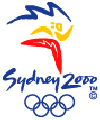 It
was Ottey's
slowest effort of the three appearances she made at the
meet. She had clocked 11.09 in the first round Thursday and
11.15 in the semifinal earlier on Friday. It
was Ottey's
slowest effort of the three appearances she made at the
meet. She had clocked 11.09 in the first round Thursday and
11.15 in the semifinal earlier on Friday.
Dowdie,
the U.S. Collegiate 200-metre champion, survived a tight
finish, to beat 1999 world championship 200-metre silver
medallist Bev
McDonald
(11.20) and Tanya Lawrence (11.21).
Ottey,
winner of seven Olympic medals and 14 world championship
medals including two gold, has been at every summer Games
since Moscow in 1980.
She
said on Friday her enforced absence from athletics as a
result of the drug-taking allegation had been like a ``death
sentence'' but she remained confident she would get in shape
in time for the Games.
Ottey
said: "In
about six weeks I can get to running under 11 seconds ...
I've done it in the past. I have the experience and I have
the confidence.''
Ottey
was banned after testing positive for the controversial
anabolic steroid nandrolone but the ban was lifted on July 3
by an International Amateur Athletic Federation panel. |
| Merlene
Ottey in semifinals |
|
Kingston,
Jamaica - July 20
 Merlene
Ottey, trying to qualify for her sixth Olympic team, advanced to
the semifinals of 100 meters Thursday at Jamaica's Olympic
trials. She won her heat race in 11.09 seconds. Merlene
Ottey, trying to qualify for her sixth Olympic team, advanced to
the semifinals of 100 meters Thursday at Jamaica's Olympic
trials. She won her heat race in 11.09 seconds.
Ottey,
who has kept a low profile since arriving in Jamaica five
days ago, had a slow start but made up ground on runner-up Tanya
Lawrence
then eased up at the line for the win.
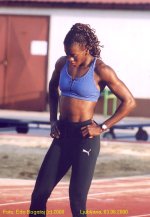 "With
30 meters to go I was in a daze, but I got going and it was
easy after that,'' she
said and than added: "With
30 meters to go I was in a daze, but I got going and it was
easy after that,'' she
said and than added:
"It
feels great to run here at home in Jamaica where I have
been running since the 1970's. I am still a bit rusty and
uncomfortable to run with others but very happy with the
improvement over last weeks 11.42 sec in Italy. I came
here to qualify for the Olympic team so it is too early to
celebrate. I am looking forward to two more good and very
competitive races tomorrow evening."
The
semifinal and final are scheduled for tomorrow July 21 at
5 pm and 7 pm respectively.
Merlene
needs to finish in the top three of Friday's
100 m final
to qualify for the event at the Sydney Olympics. |
| Here's the official announcement
of the IAAF, published on the IAAF News pages on July 7. 2000:
|
|
Details of the Merlene Ottey
Decision
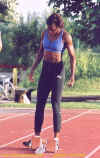 7 July 2000 - Monte Carlo -
The
reinstatement of the Jamaican athlete Merlene Ottey by the IAAF
Arbitration Panel following an adverse finding for Nandrolone, has
occasioned a number of speculative reports in the media and many
requests for further information from all parts of the World
Athletics Family. In the interests of information and
transparency, the IAAF has decided to release the full text of the
decision of the IAAF Arbitration Panel, which under the terms of
the IAAF Constitution is final and binding on all parties. 7 July 2000 - Monte Carlo -
The
reinstatement of the Jamaican athlete Merlene Ottey by the IAAF
Arbitration Panel following an adverse finding for Nandrolone, has
occasioned a number of speculative reports in the media and many
requests for further information from all parts of the World
Athletics Family. In the interests of information and
transparency, the IAAF has decided to release the full text of the
decision of the IAAF Arbitration Panel, which under the terms of
the IAAF Constitution is final and binding on all parties.
"In the matter of an arbitration
initiated by the International Amateur Athletic Federation (IAAF),
Applicant, under IAAF Rule 21 para 3 (ii) in a case where a member
of the IAAF, the Jamaican Amateur Athletic Association (JAAA),
Respondent, has held a hearing under IAAF Rule 59
"Disciplinary Procedures for Doping Offences" and the
IAAF believes that in the conduct or conclusions of such hearing
JAAA has misdirected itself or otherwise reached an erroneous
conclusion.
Whereas:
- A dispute between a Member and the
Council of the IAAF may be submitted to the Arbitration Panel
in a matter where a Member has held a hearing under Rule 59 in
a doping offence and the IAAF believes that in the conduct or
conclusions of such hearing the Member has misdirected itself
or otherwise reached an erroneous conclusion (Rule 21 para. 3
(ii));
- The JAAA is a Member of the IAAF and
has held a hearing in Ms. Merlene Ottey’s case and the IAAF
Rules are the valid rules to be applied in this case, when a
doping test has been undertaken;
- By Statement in support of its
Reference dated 29 April, 2000 under cover letter of 4 May,
2000 the IAAF Council referred to the Arbitration Panel the
matter of the decision of the JAAA of 7 December, 1999 to
exonerate Merlene Ottey of a doping offence, based on the
conclusion inter alia that on the material adduced before it,
the scientific evidence does not support an exogenous source
of the metabolites detected in the urine samples; accordingly,
the JAAA’s tribunal was not sure that the substance reported
was ingested by her and not produced endogenously.
Now we Christoph Vedder, chairman, Monty
Hacker and Judge James Murphy,
being the Arbitrators appointed from the Panel elected pursuant to
the IAAF Rules,
 Having taken note of the said Referral to
Arbitration, the Statement of IAAF in Support of its Referral, the
Response of both JAAA (dated 8 June, 2000) and of Ms. Merlene
Ottey (dated 29 May, 2000) and the documents and references in the
bundles collected by both IAAF and JAAA and on behalf of Ms.
Merlene Ottey, Having taken note of the said Referral to
Arbitration, the Statement of IAAF in Support of its Referral, the
Response of both JAAA (dated 8 June, 2000) and of Ms. Merlene
Ottey (dated 29 May, 2000) and the documents and references in the
bundles collected by both IAAF and JAAA and on behalf of Ms.
Merlene Ottey,
Having held a hearing on 16 and 17 June,
2000 and heard the various submissions made by Counsel on behalf
of IAAF and JAAA and Merlene Ottey:
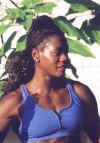 The Hon. Michael Beloff Q.C. assisted by
Mark Gay Esq. and Ms. Karen Langlois appeared for IAAF. The Hon. Michael Beloff Q.C. assisted by
Mark Gay Esq. and Ms. Karen Langlois appeared for IAAF.
The Hon. Charles Flint Q.C. appeared for JAAA
Dr. Lloyd Barnett appeared for JAAA
Dr. Stephan Netzle appeared for Ms. Merlene Ottey
And having heard the following experts:
- On behalf of the IAAF:
Dr. Martial Saugy
- On behalf of Ms.
Merlene Ottey:
Dr. Simon Davis
Dr. John Honour
Do hereby make this
decision:
- On 5 July 1999, Ms. Merlene Ottey, an
athlete under the jurisdiction of IAAF, was subject to a
post-competition test in a meeting organised by the European
Athletic Association, an Area Group, in Lucerne, Switzerland.
The "A" sample was analysed at the IOC Accredited
Laboratory in Lausanne, Switzerland on 9 July, 1999 and showed
the presence of 19-norandosterone (NA) in a concentration of
15ng/ml and of 19-noretiocholanolone (NE) in a concentration
of 10ng/ml. These two substances are metabolites of nandrolone.
- On 2 September, 1999 at the Lausanne
laboratory analysis was conducted on the "B" sample
obtained from Ms. Ottey. This analysis was attended amongst
others by Mr. Daniel Zimmerman representing the athlete, The
results of the "B" sample analysis also showed the
presence of ± 14ng/ml of 19-NA and ± 11ng/ml of 19-NE.
- The results of the "B"
analysis confirmed those of the "A" analysis and
therefore Ms. Merlene Ottey was suspended pending a hearing
before JAAA’s relevant tribunal. This tribunal heard the
case on 30 November, 1999. A written judgement was produced on
2 December, 1999 which was formally ratified by a decision of
JAAA’s Executive Board on December 7. It was determined that
Ms. Merlene Ottey had not committed a doping offence and
therefore her suspension was lifted. The JAAA based its
decision primarily on the arguments that the JAAA had failed
to prove that the sample tested positive had derived from Ms.
Ottey and that the chain of custody had been established and
that as IAAF Rules did not create an absolute offence, the
burden lay upon the JAAA to establish an exogenous source for
the finding of the prohibited substance. On the basis of the
evidence it received, the tribunal decided that it could not
be sure that the substance detected was ingested by Ms. Ottey
rather than being produced endogenously.
- By decision of 12 February, 2000 the
IAAF Council suspended Ms. Merlene Ottey by virtue of Rule
59.2 as amended.
- During the hearing, several
applications were made. Following presentation of the opening
statements by Counsel, the Arbitration Panel having considered
the suggestions put before it issued the following decision
concerning the admissibility of the reference and other
preliminary matters.
- The referral to Arbitration made by
IAAF received by the Chairman of the Arbitration Panel on 4
May, 2000 is admissible.
- Applying the rule of lenity in
favour of the respondent and the athlete the latest
application of the Rule change from 3 to 6 months would be 1
January, 2000, the date of the publication of the new
Handbook. However, the JAAA was aware of the rule change
from three to six months prior to the hearing in December as
shown by their representation at Congress on August 17 –
19, 1999, when the change was adopted as shown by the
Minutes. The rule change was outlined in the IAAF Newsletter
of September 1999, sent to all Member Federations. Under
these circumstances, the Arbitration Panel invokes Rule 21.1
sub para. 2 which allows it to accept the referral
considering it to be fair and reasonable.
- The alleged improper contact between
IAAF and the athlete has no relevance to the issue of the
admissibility and under Rule 55.11 it casts no doubt as to
the reliability of the finding that a prohibited substance
may be present in a sample.
- The point of waiver attributed to
the non-attendance by IAAF at JAAA’s hearing is rejected
as having no substance.
- The Arbitration Panel states that this
is a hearing de novo.
- During evidence, the only persons who
may be present are the parties and their representatives and
in the case of expert evidence, the opposing party’s
experts.
- The Arbitration Panel invites the
parties to address them further if they consider it necessary
on the issue of burden of proof.
- Upon resumption of the hearing, IAAF
applied for an adjournment to secure the attendance of their
expert witnesses. Having considered the arguments put forward
by both parties the Arbitration Panel issued the following
decision:
- The application is denied as far as
the matter of endogenous production is concerned. The issue of
possible endogenous production of nandrolone or its
metabolites was raised in JAAA’s decision of 7 December,
1999 and was addressed in IAAF’s statement in support of the
referral to arbitration dated 29 April, 2000.
- It appears that the issues of
"innocent substances" and the interaction of several
causes, have not been previously addressed and therefore, if
the Respondent wishes to adduce evidence on the subject, the
IAAF will be afforded a postponement to allow to respond.
The Respondent and the representative
of Ms Ottey declared that they do not continue to rely on the
subject matter of "innocent substances" understood by
common agreement as substances taken through exogenous
administration.
- At the continued hearing, IAAF made an
application to allow Prof. Hemmersbach to give testimony by
the production of a paper he had written himself and by means
of a telephone conference. The Arbitration Panel dismissed the
application.
- The respondent and Merlene Ottey’s
Counsel went on record and stipulated to acknowledge the chain
of custody, the propriety of the collection procedure, the
testing of the sample and the findings of the laboratory in
respect thereof as well as the identification of the source of
the sample as derived from Ms. Ottey. The parties agreed that
the specific gravity readings and the nanogramme readings and
the laboratory reports for the "A" and "B"
samples were not disputed. What was challenged was the method
of interpretation of these readings, regard being had to the
degree of degradation of the samples between the times of
voiding and the "A" and "B" sample
laboratory analyses respectively.
- In terms of Rule 55.2 (i) as read with
Rule 60.1 (i) a doping offence occurs when a prohibited
substance is found to be present in an athlete’s body
tissues or fluids.
- Nandrolone and its chemically or
pharmacologically related compounds is a prohibited substance
as provided for in Rule 55.3 as read with Schedule 1, Part
I(a)(i) of the Procedural Guidelines for Doping Control.
According to Rule 55.6, "prohibited substances"
shall include metabolites of their substance. However, Rule
55.2 (i) does not distinguish between exogenous administration
and endogenous production of a prohibited substance.
- According to and applying Rule 59.5,
the IAAF has the burden of proving beyond reasonable doubt
that a doping offence has been committed.
- Hence, the Rules do not require that
IAAF (or in the case under consideration the JAAA before its
relevant tribunal) has to prove that the prohibited substance
was exogenously administered. The decision of JAAA’s
Tribunal is based on a wrongful construction of the pertinent
rules.
- Merlene Ottey disputed that she had
committed a doping offence and contended that the level of
19-NA found in her samples was produced endogenously. A
growing body of evidence suggests that 19-NA is naturally
present in low but clearly detectable concentration in the
urine of men and women. This concentration appears to be
greater in women generally and particularly if pregnant or in
their menstrual cycle. It is undisputed that Ms. Ottey was
mid-cycle at the time of the Lucerne Meeting. This time is the
most fertile in terms of hormone production.
- Neither the Rules nor the Procedural
Guidelines for Doping Control consider the existence of
naturally produced nandrolone or its metabolites.
- If the Arbitration Panel were to apply
the Rules as they presently stand, the IAAF would have proved,
beyond reasonable doubt that a doping offence has been
committed. However, the panel considered the impact of
naturally produced nandrolone and its metabolites and found
that a lacuna exists in Schedule 1 Part I (a) of the
Procedural Guidelines for Doping Control as read with Rule
55.2 (i). It is because the rules as read with the Procedural
Guidelines for Doping Control provide, in the case of the
endogenous production of testosterone beyond normally
acceptable limits, a procedure designed to avoid prejudicing
the athlete. By analogy and in fairness to the athlete the
Arbitration Panel invokes and applies the underlying principle
applicable to testosterone to the issue of nandrolone.
- As stated, the IAAF bears the burden
of proving all the elements of the offence beyond reasonable
doubt. To do so, it must prove that that the quantity of 19-NA
found in Merlene Ottey’s samples so exceeds the range of
values normally found in humans as not to be consistent with
normal endogenous production. Had it done so, Merlene
Ottey’s samples would be deemed to be positive and it would
then become the burden of the athlete to prove by clear and
convincing evidence that the quantity of 19-NA found is
attributable to a pathological or physiological condition.
Therefore, the construction of the Rules and Guidelines as
relied upon by the tribunal of the JAAA and on behalf of Ms.
Ottey cannot be sustained.
- It was the IAAF’s contention that
the "A" sample showing 15ng/ml of 19-NA exceeds
normal endogenous production. Also noted was the Nagano study
carried out at the Nagano Olympic Games on 251 women athletes
following competition, none of whom produced a 19-NA sample in
excess of 5ng/ml. This and other evidence suggest an upper
limit for endogenous production of 19-NA by non-pregnant women
of 5ng/ml.
- The IOC produced a document for the
guidance of accredited laboratories, entitled "Analytical
Criteria for Reporting Low Concentrations of Anabolic
Steroids" (August 1998), which was introduced into
evidence by the parties at this hearing. The document
recommends that a report should not be issued for non-pregnant
females if the concentration in the test sample is less than
5ng/ml. It also recommends that adjustment of the reporting
concentration must be made if the specific gravity of the
urine sample is greater than 1.020. If so, the IOC recommends
increasing this minimum with regard to the amount by which the
specific gravity of the urine sample exceeds 1.020. This is
recommended as the IOC recognises that among other factors,
during intense physical activity a degree of dehydration may
occur, causing urine to become concentrated. This may increase
the measured concentration of excreted substances, possibly up
to fourfold. The James Report, a report to the UK Sports
Council from the Expert Committee, dated 18 January, 2000
referred to by all parties at this hearing, approves of this
IOC recommended procedure as the most appropriate method of
correction when necessary.
- On 5 July, 1999 Ms. Ottey competed in
both the 100m and 200m events in less than 90 minutes on a day
that produced a temperature ranging from 25.5 – 28 C between
the hours of 13h00 and 19h00. She had travelled to the meeting
by air carrier. All factors tend to support a finding of urine
concentration due to some dehydration justifying a specific
gravity reading of 1.025 when her sample was collected at the
time of the voiding.
- Applying the correction recommended by
the IOC and as approved by the James Commission, the urinary
19-NA concentrations detected equalled an average of 4.53 ng/ml
of urine which does not exceed the IOC suggested reporting
threshold of 5ng/ml for non-pregnant females. Thus Ms.
Ottey’s urine failed to display the characteristics of a
sample from an athlete who has exogenously administered
nandrolone or its metabolites.
- In applying the principles enunciated
above, IAAF has failed to prove beyond reasonable doubt that
the quantity of 19-NA found in the Merlene Ottey’s samples
exceeds normal endogenous production. According to the
evidence and the literature placed before the Arbitration
Panel, it is generally accepted that a finding of higher than
5ng/ml is not attributable to normal endogenous production.
Nevertheless, the same scientific literature, including the
IOC recommendation accepted by the parties, provides the
correction formula mentioned in paragraphs 18 and 20. The
parties also accepted that the specific gravity dipstick
reading (as converted) would fall below 5ng/ml, if it were to
be corrected.
- Under these circumstances, the issue
the Arbitration Panel had to determine was which specific
gravity reading to rely upon, either the reading taken at the
time of the voiding of the sample (1.025), or the later
readings at the time of laboratory testing (1.019) for the
purpose of triggering the correcting formula. The Arbitration
Panel found that the correct specific gravity reading to
accept would be that taken at the time of voiding, which would
thus trigger the application of the correction formula. As a
consequence, the Arbitration Panel accepts that the adjusted
19-NA reading falls below 5ng/ml and therefore would not
require the reporting of the finding of a prohibited
substance. In any event, the IAAF failed to discharge its
burden of proving, beyond reasonable doubt, that for the 19-NA
reading to be at 15ng/ml, the time for the determination of
the specific gravity had to be the time of the laboratory
testing and not at the time of voiding. Therefore the IAAF has
failed to discharge its burden of proof that a doping offence
has occurred beyond reasonable doubt.
- The JAAA and Merlene Ottey have each
made application to the Arbitration Panel for an award of
costs and disbursements occasioned by the IAAF referral to
arbitration. We find that because the parties each prevailed
in part and failed in part, it is equitable that each party
bears its own costs.
- We therefore decide:
- That the referral to arbitration
is dismissed;
- That in terms of Rule 59.2 as
amended, the suspension of Ms. Merlene Ottey expires upon
the delivery of this decision;
- That as each of the parties have
prevailed in part and failed in part, it is equitable that
each party bears its own costs. "
Christoph Vedder - Monty Hacker
- James Murphy
July 3, 2000
|
Copyright ©1996-2000.
IAAF International Amateur Athletic Federation. All rights
reserved. |
Ljubljana, July 8. 2000
|






 It
was Ottey's
slowest effort of the three appearances she made at the
meet. She had clocked 11.09 in the first round Thursday and
11.15 in the semifinal earlier on Friday.
It
was Ottey's
slowest effort of the three appearances she made at the
meet. She had clocked 11.09 in the first round Thursday and
11.15 in the semifinal earlier on Friday.




